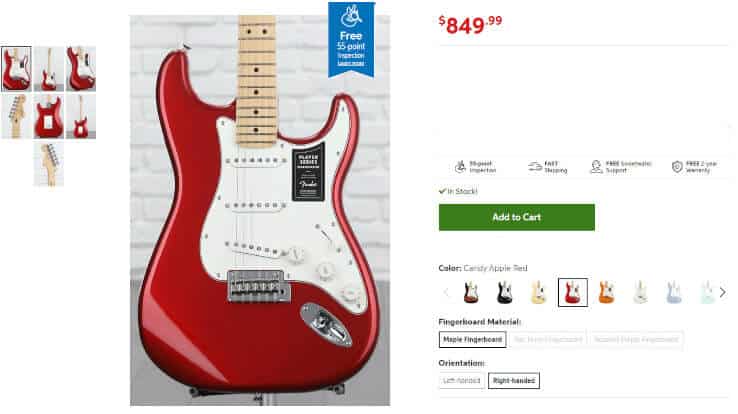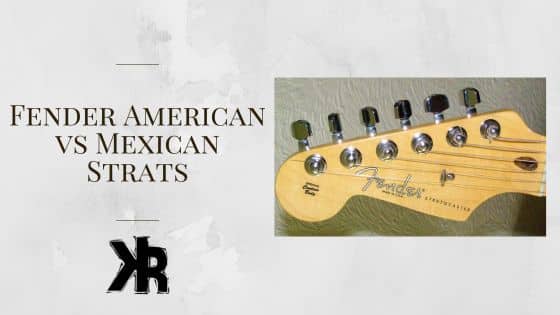Table of Contents
In the realm of electric guitars, few names are as iconic as the Fender Stratocaster. Since its inception in 1954, the Stratocaster has been at the forefront of the musical world, crafting soundscapes in countless genres from rock ‘n’ roll to blues, jazz, and beyond.
With its contoured body, three-pickup configuration, and innovative tremolo system, the Stratocaster introduced a new level of comfort, versatility, and sonic potential. One that has forever altered the landscape of music.
Over the decades, the Stratocaster’s design has evolved, embracing changes due to advancements in manufacturing techniques, shifting musicians’ needs, and market economics.
In this Killer Rig article, I have created a detailed comparison of two popular variants, the American and Mexican Stratocasters.
I’ll explore their historical evolution, the factors influencing their construction and design, and the consequential impact on their performance, playability, and price.
Quick Summary: American vs Mexican Stratocaster
When entering the world of Fender Stratocasters, one of the first decisions that a potential owner will face is choosing between the American and Mexican variants.
While both of these Strats carry the iconic legacy, they differ in certain aspects which contribute to their identity, characteristics, and, importantly, their price points.
American Stratocaster:
- Made in the USA.
- Generally more expensive than the Mexican Stratocaster.
- Has 22 frets.
- Comes with a 6-screw tremolo system.
- Has a brighter, clearer tone.
The American-made Stratocasters, crafted in Fender’s renowned Corona, California factory, represent the company’s premium range.
Known for their superior craftsmanship, these guitars are targeted towards professional musicians, serious enthusiasts, and collectors.
They come in several sub-models such as the American Standard, Professional, and Original Stratocaster, each with its dedicated offerings.
Mexican Stratocaster:
- Made in Mexico.
- Generally less expensive than the American Stratocaster.
- Has 21 frets.
- Comes with a 2-point tremolo system.
- Has a warmer, mellow tone.
The Mexican-made Stratocasters are produced in Fender’s Ensenada facility in Mexico. These guitars are designed to deliver the authentic Stratocaster experience at a more affordable price.
This makes them an attractive option for beginners, intermediate players, or budget-conscious professionals. The Mexican line includes popular models like the Player and Vintera Series Stratocaster.
Guitarist Opinions:
According to a Reddit thread, while the American Stratocaster has more prestige, Mexican Stratocasters are usually well-made workhorses with a better value/cost ratio than their American counterparts.
Yet, there are also many who consider the American options to have better quality all around, where the Mexican versions might come with some imperfections from time to time.
My Opinion:
While both variants maintain the core essence of the Stratocaster, it’s essential to note that the quality gap between the American and Mexican Stratocasters isn’t as vast as one might presume.
Mexican Strats, while more affordable, still offer commendable quality and performance. It’s also worth noting that the higher price of the American Strats isn’t merely a product of prestige!
It also reflects the tangible benefits derived from their enhanced construction, materials, and features.
Unraveling the Price and Models Available
As we venture into the realm of cost, it’s clear that a significant price disparity exists between American and Mexican Stratocasters.
Typically, American Strats command a higher price due to various factors such as superior materials, advanced features, and the costs associated with manufacturing in the US.
An American Stratocaster could cost anywhere from $1,400 to over $2,600, depending on the specific model and features.
On the flip side, Mexican Stratocasters are significantly more affordable. Their price tag reflects the cost savings of manufacturing in Mexico, along with the use of less expensive components and simpler features.
These guitars offer a much more accessible entry point into the Stratocaster world, with prices typically ranging from $850 to $1,200.

Model Comparison
The American Stratocaster lineup features several models, each catering to a particular taste or requirement. Some popular models include the American Standard, known for its timeless design and versatile tones.
The American Professional, offering modern playability with classic vibes. And the American Original Stratocaster, which celebrates the historic design elements of vintage Strats.
Mexican Stratocasters, too, offer a variety of models, each delivering a special flavor of the Strat experience. The Player Series, for instance, combines traditional aesthetics with modern playability and tonal versatility.
The Vintera Series Stratocaster, meanwhile, is designed to evoke specific vintage eras, offering period-correct neck profiles, hardware, and pickups.
Both American and Mexican Stratocasters present a range of models, each with its own appeal, ensuring that there’s a Strat for every guitarist, regardless of their preference or budget.
This table provides a comparison of the models and price points:
| Model | Origin | Price USD |
|---|---|---|
| Player | Mexico | $850.00 |
| Player Plus | Mexico | $1100.00 |
| Vintera | Mexico | $1100.00 |
| Vintera Modified | Mexico | $1200.00 |
| American Performer | USA | $1400.00 |
| American Professional II | USA | $1700.00 |
| American Vintage II | USA | $2100.00 |
| American Ultra | USA | $2200.00 |
| American Ultra Luxe | USA | $2600.00 |
Build and Materials
Next, let’s explore some of the difference in build and materials to see just how different they really are.
Body and Neck Construction
When we compare American and Mexican Stratocasters, the finer nuances lie in their construction and the materials used. American Stratocasters are renowned for their meticulous craftsmanship, and this extends to their choice of tonewoods.
Predominantly, they use high-quality alder or ash for the body and maple for the neck, contributing to a rich, resonant tone. These bodies are also constructed using 2 or 3 pieces. This provides a better aesthetic.
Mexican Stratocasters, while maintaining commendable build quality, use more readily available and cost-effective alternatives for the body, such as poplar. The bodies are also normally 5 pieces as they try and use up all the material. Depending on the finish, this might be seen in the wood grain.
They usually feature maple necks like their American counterparts. Albeit often with a satin finish as opposed to the gloss commonly found on American models.
But both provide a modern C-shaped neck with a 9.5″ fingerboard radius. You will also find that they normally come with 22 frets, depending on the model, of course.
Fretboard Material
In recent years, due to CITES regulations restricting the usage of rosewood, Fender transitioned to using Pau Ferro in many Mexican models. Pau Ferro offers similar tonal properties to rosewood but with a lighter color and slightly harder consistency.
American models, however, often still utilize rosewood, complementing their high-end appeal with its rich, warm tonality and aesthetic charm.

Body Finishes
Another noteworthy difference lies in the body finishes. Mexican Strats typically sport a polyester finish, which, while durable, is often considered less resonant than the polyurethane or nitrocellulose finishes found on American models.
Nitrocellulose, in particular, is revered for its ability to breathe, enabling the wood to resonate more freely and mature aesthetically over time.
Through these small differrences in construction and materials, both American and Mexican Stratocasters carve out their identities, impacting their tonal characteristics, aesthetic appeal, and playability.
Pickups
The pickup configuration is another defining aspect of the Stratocaster’s identity, significantly influencing its tone.
American Stratocasters usually sport Fender’s higher-end pickups, like the V-Mod or Custom Shop Fat ’50s. They are known for their nuanced tonal response, enhanced clarity, and dynamic range. These are made in the USA and are the best they have to offer.
On the other hand, Mexican Stratocasters often come with Fender’s Standard Single-Coil Strat or Player Series Alnico pickups. These pickups are often made in Mexico or Korea, depending on the cost to acquire them.
While they may not offer the same level of tonal complexity as the American versions, these pickups do deliver a very satisfying Stratocaster sound!
Tone Comparison
When it comes to tone, American Stratocasters generally offer a wider dynamic range, enhanced clarity, and more tonal depth, courtesy of their superior pickups and high-quality tonewoods.
They shine in professional settings, delivering a level of performance that satisfies even the most discerning ears.
Mexican Stratocasters, despite their more affordable components, still manage to deliver an authentic and enjoyable Stratocaster tone.
They capture the quintessential bright, punchy character that Strats are loved for, making them suitable for a range of musical styles and settings.
It’s important to note, however, that tone is highly subjective. What sounds “better” can vary greatly for each player. This is all based on personal preferences, playing style, and the musical context.
For me, I am just as happy playing a Mexican made Stratocaster as long as it provides the tone one would expect. I’ve played many models, and they all have their own Strat style voicing. As such, both American and Mexican Strats can find their place in different tonal landscapes.
Check out this video by Rhett Schull. He played many different Stratocaster models to compare their sound and performance:
Examining Hardware and Features
When we inspect the hardware, significant differences emerge between American and Mexican Stratocasters.
American Strats commonly feature bridges made of steel with nickel-plated saddles, a robust and durable construction known to provide superior resonance and sustain.
They come with both two-point synchronized and traditional six-point tremolo systems, depending on the specific model, allowing for smooth and stable whammy bar usage.
Additionally, American Stratocasters are equipped with high-quality tuning machines, often with staggered heights. They deliver improved string break angle and superior tuning stability.
Mexican Stratocasters, on the other hand, utilize more cost-effective materials for their bridges, which are typically chrome-dipped.
Similar to the American Strats, Mexican models also come with either vintage-style six-screw bridges or two-point synchronized tremolo designs, providing a more traditional feel and aesthetic.
The tuning machines on Mexican Strats, while reliable, might not offer the same level of precision or stability as those found on American models.
Other Features
There are further distinguishing elements between American and Mexican Stratocasters, which can be found in the form of gig bag inclusion, headstock decals, among other aspects.
More expensive American Strats usually come with a hardshell case, offering better protection, whereas Mexican models often include a gig bag. But some don’t provide one at all, which might cost $120.00 to buy separately.
The headstock decals also differ, providing clear information on the model name and origin. Otherwise, the headstocks themselves are the same great Fender design!
Resale Value
Resale value is a key consideration when investing in a musical instrument, particularly when it comes to iconic models like the Fender Stratocaster.
As we evaluate the resale value of American and Mexican Stratocasters, it’s apparent that both have different depreciation patterns, largely driven by their original cost, build quality, and perception within the musician community.
American Stratocasters, due to their premium build, and the prestige associated with American-made instruments, tend to retain their value more effectively.
On average, a well-maintained American Strat might see a depreciation of approximately 15-20% from its original retail price on the second-hand market.
However, given that American Strats come with a higher initial cost, ranging from $1,200 to over $2,600, the absolute dollar amount lost due to depreciation could be significant. For instance, a 20% depreciation on a $2,000 American Strat would equate to a $400 loss in value.
On the flip side, Mexican Stratocasters, while made with cost-effective materials and positioned as a more affordable alternative, do see a steeper depreciation rate, typically around 25-30%.
That said, since their original retail prices hover between $600 to $1,200, the absolute loss in dollar terms would likely be less than that of an American Strat. For example, a 30% depreciation on a $800 Mexican Strat amounts to a $240 decrease in value.
While these figures offer a general guideline, it’s critical to remember that many factors can influence a guitar’s resale value, such as its condition, rarity, and the demand in the second-hand market at the time of selling.
A well-cared-for Stratocaster, regardless of its country of origin, can hold its value admirably and might even appreciate in some circumstances, such as with certain limited-edition models.

Factories and Quality Control
Fender Stratocasters, whether American or Mexican, are products of a longstanding heritage of craftsmanship and quality.
However, the factories where they’re manufactured and the quality control processes they undergo offer additional insights into their specific characteristics.
Corona, California vs Ensenada, Mexico
American Stratocasters are crafted in Fender’s renowned Corona, California factory. This facility is known for its artisanal approach, combining advanced manufacturing technology with skilled handcrafting.
Each guitar is meticulously constructed and thoroughly inspected, ensuring that every American Strat that leaves the factory meets Fender’s high standards of excellence.
Mexican Stratocasters are manufactured in Fender’s Ensenada, Mexico factory. Although this factory also employs skilled craftspeople and modern manufacturing processes, the focus here leans more towards efficiency and affordability.
As a result, the Mexican Strats are able to maintain a commendable level of quality while being accessible to a broader range of musicians.
Quality Control
Quality control is paramount at Fender, regardless of where the instruments are made. Both the American and Mexican Stratocasters undergo rigorous testing and quality checks to ensure they meet Fender’s standards.
However, the American models, due to their premium positioning, often receive a higher degree of scrutiny. These guitars are thoroughly checked for any imperfections, ensuring that everything from the finish to the electronics and setup is flawless.
This level of attention to detail contributes to their higher price tag, but it also ensures a superior level of consistency and performance.
Mexican Stratocasters, while also subject to quality checks, might not receive the same exhaustive scrutiny due to their lower price point and higher production volume.
That said, they still deliver a quality that’s respected worldwide and adheres to Fender’s commitment to craftsmanship.
When to Choose a Mexican Stratocaster
Opting for a Mexican Stratocaster is an excellent choice for several reasons. If you’re an aspiring musician taking your first steps in the electric guitar world or an intermediate player seeking a quality upgrade without breaking the bank, the Mexican Strat is a compelling proposition.
It offers the quintessential Strat experience, the iconic design, the versatile tone, and the renowned Fender craftsmanship, at a more accessible price point.
Furthermore, Mexican Strats serve as reliable workhorses for touring musicians, offering a blend of durability and performance that won’t let you down on the road. They also make great backup instruments, ensuring you’re never left high and dry during a gig.
Why Choose an American Stratocaster?
Choosing an American Stratocaster is an investment in superior craftsmanship, tonal excellence, and the prestigious lineage of American-made instruments.
If you’re a professional musician, a dedicated hobbyist, or a collector, the American Strat delivers a level of quality and performance that justifies its premium price tag.
The American Strat’s tonal richness, coupled with its smooth playability and high-end materials, makes it an instrument you’ll cherish for years to come. The higher resale value and the prestige associated with the “Made in USA” label further add to its appeal.
Your choice between a Mexican and American Stratocaster boils down to your personal musical goals, your budget, and what you value most in a guitar.
Whether you choose the budget-friendly versatility of the Mexican Strat or the premium performance of the American Strat, you’re becoming part of the illustrious Fender Stratocaster family! A legacy that has shaped the landscape of music for over seven decades.
Conclusion
Navigating the landscape of Fender Stratocasters, it becomes apparent that both the American and Mexican models hold their own appeal, each tailored to specific needs, skill levels, and budgetary constraints.

